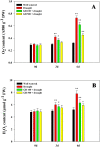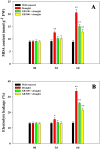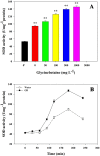Glycinebetaine mitigates drought stress-induced oxidative damage in pears
- PMID: 34793480
- PMCID: PMC8601463
- DOI: 10.1371/journal.pone.0251389
Glycinebetaine mitigates drought stress-induced oxidative damage in pears
Retraction in
-
Retraction: Glycinebetaine mitigates drought stress-induced oxidative damage in pears.PLoS One. 2022 Nov 16;17(11):e0277597. doi: 10.1371/journal.pone.0277597. eCollection 2022. PLoS One. 2022. PMID: 36383549 Free PMC article. No abstract available.
Abstract
Glycinebetaine (GB) is an osmoprotectant found in plants under environmental stresses that incorporates drought and is associated with drought tolerance in several plants, such as the woody pear. However, how GB improves drought tolerance in pears remains unclear. In the current study, we explored the mechanism by which GB enhances drought tolerance of whole pear plants (Pyrus bretschneideri Redh. cv. Suli) supplied with exogenous GB. The results showed that on the sixth day after withholding water, levels of O2·-, H2O2, malonaldehyde (MDA) and electrolyte leakage in the leaves were substantially increased by 143%, 38%, 134% and 155%, respectively. Exogenous GB treatment was substantially reduced O2·-, H2O2, MDA and electrolyte leakage (38%, 24%, 38% and 36%, respectively) in drought-stressed leaves. Furthermore, exogenous GB induced considerably higher antioxidant enzyme activity in dry-stressed leaves than drought-stressed treatment alone on the sixth day after withholding water, such as superoxide dismutase (SOD) (201%) and peroxidase (POD) (127%). In addition, these GB-induced phenomena led to increased endogenous GB levels in the leaves of the GB 100 + drought and GB 500 + drought treatment groups by 30% and 78%, respectively, compared to drought treatment alone. The findings obtained were confirmed by the results of the disconnected leaf tests, in which GB contributed to a substantial increase in SOD activity and parallel dose- and time-based decreases in MDA levels. These results demonstrate that GB-conferred drought resistance in pears may be due in part to minimizing symptoms of oxidative harm incurred in response to drought by the activities of antioxidants and by reducing the build-up of ROS and lipid peroxidation.
Conflict of interest statement
The authors have declared that no competing interests exist.
Figures






Similar articles
-
[Effects of glycinebetaine on ultraweak luminescence and anti-oxidative capability of Malus hupehensis under drought stress].Ying Yong Sheng Tai Xue Bao. 2006 Dec;17(12):2394-8. Ying Yong Sheng Tai Xue Bao. 2006. PMID: 17330487 Chinese.
-
Glycinebetaine alleviates the chromium toxicity in Brassica oleracea L. by suppressing oxidative stress and modulating the plant morphology and photosynthetic attributes.Environ Sci Pollut Res Int. 2020 Jan;27(1):1101-1111. doi: 10.1007/s11356-019-06761-z. Epub 2019 Dec 9. Environ Sci Pollut Res Int. 2020. PMID: 31820244
-
Differential response of quinoa genotypes to drought and foliage-applied H2O2 in relation to oxidative damage, osmotic adjustment and antioxidant capacity.Ecotoxicol Environ Saf. 2018 Nov 30;164:344-354. doi: 10.1016/j.ecoenv.2018.08.004. Epub 2018 Aug 18. Ecotoxicol Environ Saf. 2018. PMID: 30130733
-
Transcriptome expression profiles reveal response mechanisms to drought and drought-stress mitigation mechanisms by exogenous glycine betaine in maize.Biotechnol Lett. 2022 Mar;44(3):367-386. doi: 10.1007/s10529-022-03221-6. Epub 2022 Mar 16. Biotechnol Lett. 2022. PMID: 35294695 Review.
-
Glycine betaine and plant abiotic stresses: Unravelling physiological and molecular responses.Plant Sci. 2025 Jun;355:112479. doi: 10.1016/j.plantsci.2025.112479. Epub 2025 Mar 23. Plant Sci. 2025. PMID: 40132665 Review.
Cited by
-
Melatonin Enhances Drought Tolerance in Rice Seedlings by Modulating Antioxidant Systems, Osmoregulation, and Corresponding Gene Expression.Int J Mol Sci. 2022 Oct 11;23(20):12075. doi: 10.3390/ijms232012075. Int J Mol Sci. 2022. PMID: 36292930 Free PMC article.
-
Genome-wide characterization of SmZHD gene family and the role of SmZHD12 in regulating anthocyanin biosynthesis in eggplant (Solanum melongena L.).Plant Cell Rep. 2024 Apr 8;43(5):114. doi: 10.1007/s00299-024-03195-x. Plant Cell Rep. 2024. PMID: 38587681
-
Exogenous betaine enhances salt tolerance of Glycyrrhiza uralensis through multiple pathways.BMC Plant Biol. 2024 Mar 2;24(1):165. doi: 10.1186/s12870-024-04851-w. BMC Plant Biol. 2024. PMID: 38431542 Free PMC article.
-
Integrated transcriptome and methylome analyses reveal the molecular regulation of drought stress in wild strawberry (Fragaria nilgerrensis).BMC Plant Biol. 2022 Dec 28;22(1):613. doi: 10.1186/s12870-022-04006-9. BMC Plant Biol. 2022. PMID: 36575384 Free PMC article.
-
Pan-metagenome reveals the abiotic stress resistome of cigar tobacco phyllosphere microbiome.Front Plant Sci. 2023 Dec 21;14:1248476. doi: 10.3389/fpls.2023.1248476. eCollection 2023. Front Plant Sci. 2023. PMID: 38179476 Free PMC article.
References
-
- Ali Q, Ali S, Iqbal N, Javed MT, Rizwan M, Khaliq R, et al.. Alpha-tocopherol fertigation confers growth physio-biochemical and qualitative yield enhancement in field grown water deficit wheat (Triticum aestivum L.). Scientific reports. 2019;9(1):1–15. doi: 10.1038/s41598-018-37186-2 - DOI - PMC - PubMed
-
- Farooq A, Bukhari SA, Akram NA, Ashraf M, Wijaya L, Alyemeni MN, et al.. Exogenously applied ascorbic acid-mediated changes in osmoprotection and oxidative defense system enhanced water stress tolerance in different cultivars of safflower (Carthamus tinctorious L.). Plants. 2020;9(1):104. - PMC - PubMed
Publication types
MeSH terms
Substances
LinkOut - more resources
Full Text Sources

